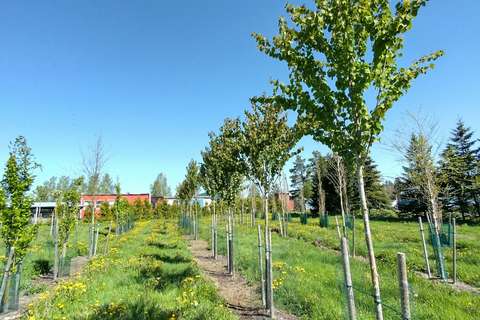City Garden’s tree bank helps Espoo adapt to climate change

Global warming will bring Central European climate to Espoo in the near future. The city is adapting to climate change with an experiment where southern tree species are grown for future use in the cityscape.
Lush greenness and proximity to nature are a part of the local landscape in Espoo. Environmental Specialist Anna Ikonen knows that trees and other plant life are not only beautiful, but also very useful.
– Vegetation can be used as a nature-based solution to absorb rainwater into the soil without expensive artificial solutions.
Ikonen notes that the benefits of trees are nowadays identified and taken into account much more than before. In Espoo, trees are planted in streets and parks whenever possible.
The City Garden grows new trees for Espoo’s streets and parks
As the climate becomes warmer, local conditions become more favourable to species that have previously been rare in the area. Researchers have estimated that growth conditions in Finland will soon resemble current conditions in Germany and Poland if global warming continues at its current pace.
Sari Turkka, Garden Manager of the Espoo City Garden, explains preparations for this change must be made now.
– We grow trees in the tree bank so that they can later be planted in the streets and parks of Espoo. We recently started an experiment to determine which southern tree species can thrive in Finnish urban conditions in the future.
The City Garden has tree species that have thrived in places like southern Sweden. Saplings are allowed to grow in the City Garden for approximately 4–10 years, depending on the species. By the time they are permanently planted elsewhere, the climate will probably have become warmer.
– Our experiment includes dozens of new species. One promising species is the Turkish hazel, which has already been successfully grown in Turku. The Japanese Katsura tree has also grown surprisingly well in the tree bank’s clay soil, Turkka explains. – Its round leaves have a pleasant smell in the autumn.
The new tree species can be introduced to Espoo’s cityscape within the next few years.
New species will not replace domestic ones
The foreign trees are not meant to replace domestic tree species entirely. However, some tree species currently found in Espoo will not withstand warmer conditions, and their habitats will therefore move further north.
Turkka points out that a lack of diversity in species makes trees more susceptible to plant diseases and pests.
– For example, elms are popular trees in cities due to their durability and beauty. But if there are only elms around and a harmful insect species starts destroying them, all the trees will be lost at once.
Ikonen agrees that planting different tree species improves the resilience of urban nature.
– In terms of biodiversity, having too few species of trees is not a sustainable solution. But we’re not going to replace all birches with Turkish hazels either, Ikonen promises.
Trees provide shade, cool the air and filter rainwaters
People should take good care of the trees in their own yards, as they offer many benefits. Trees provide shade and cool the air during sunny weather and help absorb rainwater into the soil during heavy rain. Birds, insects and other lifeforms take shelter in trees, often without us even noticing them.
Growth conditions of a property determine which tree species is most suitable for growing there.
– For example, pines can thrive in dry places, whereas oaks and maples grow better in rich soil. The changing natural conditions will make deciduous trees increasingly common in Espoo in the future, Ikonen notes.
However, Ikonen points out that an already full-grown tree always offers more benefits than a newly planted sapling. Therefore, a firmly rooted tree should not be cut down just to make room for a more suitable species.
You can learn more about the benefits of having trees in your property by reading the Stand by your tree brochure.